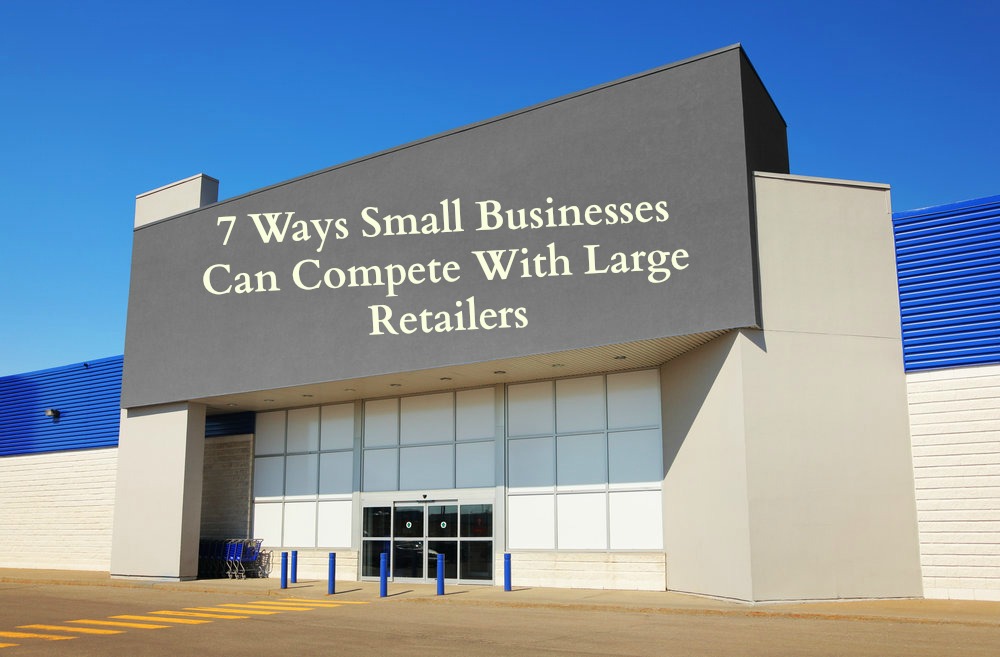Wasp Barcode Technologies: The Barcode Solution People
7 Ways Small Businesses Can Compete With Large Retailers

When we think about shopping in the modern era, the names of big-box retailers and online shopping giants often come to mind, whether it’s the Black Friday deals of Amazon or the discounts offered by Target and Best Buy by way of
free shipping throughout December. The rising tide of gift-giving raises all boats, and even small businesses see increased sales as the economy improves and the holidays approach.
In fact, over the last 12 months,
small business retail has accounted for almost 40 percent of total retail sales, meaning that they are outperforming their large retail brethren, thanks to a number of factors, including consumers prizing unique products and supporting the local economy over getting the best possible deal.
[Tweet "Over the last 12 months, small business retail has accounted for almost 40 percent of total retail sales."]
This emerging mindset, powered mainly by millennials, coupled with the advent of new technology makes the upcoming holiday season (as well as the next few to come) the perfect time for small- and medium-sized businesses to compete with large retailers, regardless of scale. If you’re a business owner looking to go toe-to-toe with a retailer like Amazon (which can produce and ship products more quickly than almost any other company), consider the following strategies in order to emerge a winner come January.
1. Focus on what makes you unique
Trying to beat the big retailers at their own game will likely be a losing battle. If you carry the same products as everyone else, there will be little reason to shop from you as opposed to a business that can beat you on price. On the other hand, carrying hard-to-find, handmade or otherwise unique products can set you apart.

“I do think that uniqueness is what everybody’s chasing,” Rod Sides, leader of retail and distribution practice at Deloitte, recently told CNBC. “Whether it be a unique experience or whether it be a unique gift, those local boutiques kind of have that flair.”
2. Take control of your supply chain
The movement of materials, information and finances from your supplier all the way through to the retailer and consumer is the supply chain. Businesses must often trust other companies, such as shippers, to seamlessly continue the steady flow of inventory and income. The best way to ensure the flow never stops (especially around holiday time) is to achieve visibility along your supply chain, always knowing where materials have come from, where they are and where they’re going. A surprising 40 percent of manufacturers lack visibility, which comes from a combination of trusting partners, hiring skilled staff and investing in the right technology, such as global demand planning and even the simple barcode.
3. Create your own barcodes
The technology needed to track inventory along the supply chain has actually been around for decades. Barcodes, both traditional (also known as 1D or linear) and 2D (usually QR codes), are becoming the standard thanks to the spread of mobile computers, wireless barcode scanners and even
smartphones with barcode reading apps. You no longer need to go to a third-party to get started with barcodes: You can design and print your own using everything from a desktop barcode printer to an industrial warehouse model.
4. Balance inventory turnover ratio
One of the
key metrics for small businesses is inventory turnover ratio, which is the cost of goods sold divided by average inventory. A low ratio indicates you spend too much money on holding costs (such as rent and insurance) and that products may be deteriorating on your shelves. A high ratio, on the other hand, may mean you won’t have enough inventory to cover demand, losing valuable business. Pulling rather than pushing inventory is the key to success because you will always have enough inventory without burning money on unnecessary costs.
5. Monitor fixed assets
Fixed assets, as opposed to inventory, are the long-term pieces of property used to create income, such as computers and vehicles. There are a myriad of costs associated with fixed assets, however, such as the cost of replacing lost or stolen items or time spent repairing assets that did not receive regular maintenance. A quality asset tracking system helps you track the check-in/check-out of assets, monitors needed maintenance, alerts you when warranties will expire and tracks depreciation, for both tax accounting and physical deterioration purposes.

6. Ditch spreadsheets entirely
Excel spreadsheets are as common as desk chairs to most businesses, but just because they’ve been used for decades doesn’t mean they should continue to be used going forward. Manual data entry is simply too susceptible to errors, which can affect year-end audits that lead to inventory and asset write-offs. Manual entry also requires hand counts of items by employees as well as manual re-ordering of popular products, which is a huge time suck. Move to an automated inventory management system to accelerate and improve your process.
7. Embrace mobile device management software
Real-time data access for employees who work off-site, on the road or at various locations is crucial, which is why more businesses are adopting B.Y.O.D.(bring your own device) policies that allow workers to tap into the company’s database from their smartphone or laptop. But in order for your business to maintain proper security (so vital information is not stolen) as well as to ensure employees have consistent and reliable access, you must embrace management software that your IT team can use to monitor enabled devices. The hurdles of security and limiting employee access to certain features while using their devices for work are the next great challenges companies will face in the digital age, ones that can cost their companies time and energy without a managed application or SaaS.
8. Take advantage of the sharing economy
Businesses that sell to a local population can take advantage of upgrades to the sharing economy to deliver on short notice. Uber recently rolled out a delivery service,
UberRUSH, and other start-ups and freelancing individuals are also entering the marketplace to help businesses deliver products to consumers quickly. That last-second gift idea no longer has to wait until the week after Christmas, you can deliver it the same day, in some cases, which will incentivize purchases and engender positive customer service feedback.
Having a unique business and setting up shop in an area where people love to support the local economy is a major boom for any business owner. The difference between the best large retailers and those that suffer (as well as some small businesses) is their ability to manage the backend of business, asset management, training and technolog, so well. Losing money due to bad management is a poor excuse for why small- and medium-sized businesses can’t compete with large retailers, especially when the adoption of the technology needed to do so is cheaper and easier than ever.
 When we think about shopping in the modern era, the names of big-box retailers and online shopping giants often come to mind, whether it’s the Black Friday deals of Amazon or the discounts offered by Target and Best Buy by way of
When we think about shopping in the modern era, the names of big-box retailers and online shopping giants often come to mind, whether it’s the Black Friday deals of Amazon or the discounts offered by Target and Best Buy by way of 



